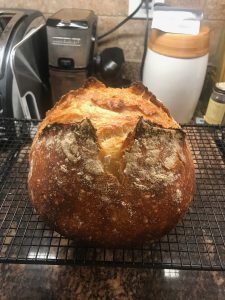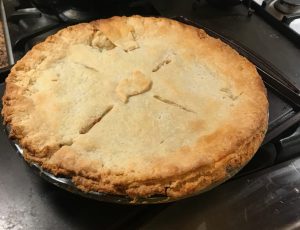
My high school boyfriend and I are, these days, buds on Facebook, and therefore he is privy to my posts about baking and cooking. After I had extolled the wonders of what I made for dinner one night (chicken pot pie with sourdough pie crust), he asked “What’s with all the Sourdough?”
Being at times intractably didactic, I explained to him that when the lockdown started and a lot of people started baking at home, yeast was, initially, hard to find. As in unicorn-difficult. So many people started sourdough cultures, which when properly grown will produce all the leavening a loaf of bread could want–plus a slight tangy flavor that many people find pleasing.
It was only after I had said all this that I realized that he might have been asking why I kept talking about sourdough, so I had to explain that the way you keep your starter alive is by periodically giving the yeast in the starter more food: water and flour. To do this you measure out some starter, add an equivalent amount of water and flour, mix and let ripen. The starter you didn’t use? It is referred to as discard, and you throw it out (so that you do not wind up with enough unfed discard that it threatens to take over your home and devour the cat) or find alternate uses for it. At the moment I have a quart of discard in my fridge (and my regular starter ripening on the counter before it goes into hibernation in the fridge as well).
So far, in seeking ways to use up my discard, I have made sourdough pasta, sourdough pie crust, sourdough peach cobbler, sourdough pretzels, sourdough crackers, and sourdough crumpets.

I have found, additionally, recipes for sourdough cakes and brownies, but I have not ventured quite the far afield. Really, my goal is not to be buried in the discard (or keep composting it until the entire of San Francisco has been consumed from below by yeasts).
An interesting side effect of all this sourdough making and feeding is that my kitchen is spattered with small dots and smears of dried sourdough starter. It is, after all, flour and water, and when it dries, it is remarkably tenacious. I’m not sure if the yeast in the mix makes the stuff more tenacious than plain old flour-and-water paste.
This subject actually has some cross over into my day job at the American Bookbinders Museum; when we talk about early bookbinding methods, we talk about the two prevalent adhesives used in Gothic bookbinding: collagen-based glue and vegetable-based paste. Collagen-based glue is made by boiling down bones or skins until what you get is a thick, smelly glue that had to be kept hot to be usable, and when dried, holds tenaciously. Once you glued something with animal glue, it stayed glued; undoing it would mean wrecking the object you were working on. Vegetable glue, AKA paste, was simply flour and water. It holds pretty much with the same tenacity–but it can be undone by soaking the glued item in water until the glue releases. Both adhesives were used in bookbinding at various times and for various reasons.
So I’ve got a kitchen that looks a little bit like a bookbinder has been playing fast-and-loose with the paste brush. But I promise, I’m not flecking starter around for fun. You feed the starter and a drip or two fall on the counter; by the time you’re finished stirring the starter to mix in all the flour, that drip is rock hard. You have a splash of starter, unnoticed, at the base of your thumb; when you open the fridge to put the discard away, you leave a smear on the handle. You open a cupboard for… well, something, and leave a little dab of starter behind. And if you’re me and move quickly from point A to point B, you don’t notice the dabs and flecks until another time. Then, when you try to remove all this leftover paste? It can be done, but it doesn’t yield to a quick swipe. Dried starter wants to be wetted a bit before it will release. It will, but it takes longer than you expect (certainly longer than I want to spend). So, I admit with shame, I sometimes “don’t see” it. What you don’t see, you don’t clean, right?
Does this matter? Maybe not so much. I love bread. The crustier and more rustic, the better. And sourdough tends to yield a really nice crusty loaf. With a smear of good butter? Sublime. And I love the process of making bread, even of keeping the starter alive. When I was 13 I spent the summer baking bread for sale; doing this from my parents’ kitchen convinced me that I was not ready for production baking, but I love the chemistry of it, and how each stage leads to the next, until suddenly you have a brown, crusty loaf that smells like home and joy.
If I hold true to form, some afternoon I will have had enough, and will soak a couple of rags and attack all the dribs and drabs in the kitchen. Until then? I’m willing to put up with some speckles for for the scent of bread warming the house.

Do you have a recipe for that no-knead sourdough? My sweetheart got into making starter, but we also got our hands on a yeast supply, so he’s not using the starter much right now (he likes a sandwich loaf and that’s easier to make with yeast). I, otoh, would like to try making chocolate sourdough, but I don’t know how to combine the no-knead approach with sourdough.
So far I’ve been mostly using recipes from King Arthur flour, and I really love their no-knead recipe, found here. https://www.kingarthurbaking.com/recipes/no-knead-sourdough-bread-recipe
Thanks. That looks similar to the no-knead artisan bread recipe I use, except that it explains how to do that with sourdough starter instead of yeast, which my book does not. I’ll give it a try.
Report back!
In the days when I made bread (which is still whenever I can get away with it, but I need people to eat it for me these days) I used a metal egg lifter with a sharp edge to get rid of spatters.
Also, your bookbinding story reminding me of the origins of margarine. If you go back to the 19th century, stick to butter? I suspect we lost that when horses ceased to be transport animals.
Gillian
I stick to butter anyway–particularly because, as a child I encountered the last hold-out in the butter wars in the midwest (I think it was Wisconsin?) where if you bought margarine it came with a little packet of food coloring, and you mixed the white oleo with the color and came up with something butterish colored (this was because the dairy lobby did not want anyone confusing the dead-fish white margarine with real butter at the store. Apparently in earlier days the food coloring was pink!).
And at least here in the states, one of the rights of childhood when I was small was “making butter” with cream in a baby food jar, shaking and shaking until it coalesced into a lump of something you could smear on toast.